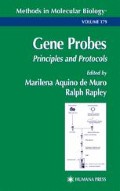Abstract
Fluorescence in situ hybridization (FISH) of whole cells using 16S rRNA-targeted oligonucleotide probes is a powerful technique with which to evaluate the phylogenetic identity, morphology, number, and spatial arrangements of microorganisms in environmental settings (1). Probes can be designed to specifically target narrow to broad phylogenetic groups (from species to domain) by virtue of variable evolutionary conservation within the 16S rRNA molecule (2). The major steps in probe design are identifying short regions (usually 15–25 nucleotides in length) in a sequence alignment unique to the target group of interest, centralizing mismatches to nontarget organisms (where possible), and modifying the sequence to meet probe design criteria such as a minimum melting temperature.
Access this chapter
Tax calculation will be finalised at checkout
Purchases are for personal use only
References
Amann, R. I., Ludwig, W., and Schleifer, K. H. (1995) Phylogenetic identification and in situ detection of individual microbial cells without cultivation. Microbiol. Rev. 59, 143–169.
Woese, C. R. (1987) Bacterial evolution. Microbiol. Rev. 51, 221–271.
Amann, R., Snaidr, J., Wagner, M., Ludwig, W., and Schleifer, K.-H. (1996) In situ visualization of high genetic diversity in a natural microbial community. J. Bacteriol. 178, 3496–3500.
Giovannoni, S. J., DeLong, E. F., Olsen, G. J., and Pace, N. R. (1988) Phylogenetic group-specific oligodeoxynucleotide probes for the identification of single microbial cells. J. Bacteriol. 170, 720–726.
DeLong, E. F., Wickham, G. S., and Pace, N. R. (1989) Phylogenetic stains: ribosomal RNA-based probes for the identification of single cells. Science 243, 1360–1363.
Stahl, D. A. and Amann, R. I. (1991) Nucleic acid techniques in bacterial system-atics. In Development and Application of Nucleic Acid Probes (Stackebrandt, E. and Goodfellow, M., eds.), John Wiley & Sons, New York, New York, 205–248.
Manz, W., Amann, R., Ludwig, W., Wagner, M., and Schleifer, K.-H. (1992) Phylogenetic oligodeoxynucleotide probes for the major subclasses of Proteobacteria: problems and solutions. Syst. Appl. Microbiol. 15, 593–600.
Fuchs, B. M., Wallner, G., Beisker, W., Schwippl, I., Ludwig, W. and Amann, R. (1998) Flow cytometric analysis of the in situ accessibility of Escherichia coli 16S rRNA for fluorescently labeled oligonucleotide probes. Appl. Environ. Microbiol. 64, 4973–4982.
Fuchs, B. M., Glöckner, F. O., Wulf, J., and Amann, R. (2000) Unlabeled helper oligonucleotides increase the in situ accessibility to 16S rRNA of fluorescently labeled oligonucleotide probes. Appl. Environ. Microbiol. 66, 3603–3607.
Brosius, J., Dull, T. J., Sleeter, D. D., and Noller, H. F. (1981) Gene organization and primary structure of a ribosomal RNA operon from Escherichia coli. J. Mol. Biol. 148, 107–127.
Amann, R. I., Krumholz, L., and Stahl, D. A. (1990) Fluorescent-oligonucleotide probing of whole cells for determinative, phylogenetic, and environmental studies in microbiology. J. Bacteriol. 172, 762–770.
Alm, E. W., Oerther, D. B., Larsen, N., Stahl, D. A., and Raskin, L. (1996) The oligonucleotide probe database. Appl. Environ. Microbiol. 62, 3557–3559.
Neef, A., Amann, R., Schlesner, H., and Schleifer, K.-H. (1998) Monitoring a widespread bacterial group: in situ detection of planctomycetes with 16S rRNA-targeted probes. Microbiology 144, 3257–3266.
Roller, C., Wagner, M., Amann, R., Ludwig, W., and Schleifer, K.-H. (1994) In situ probing of Gram-positive bacteria with high DNA G+C content by using 23S rRNA-targeted oligonucleotides. Microbiology 140, 2849–2858.
Beimfohr, C., Krause, A., Amann, R., Ludwig, W., and Schleifer, K.-H. (1993) In situ identification of lactococci, enterococci and streptococci. Syst. Appl. Microbiol. 16, 450–456.
Erhart, R., Bradford, D., Seviour, R. J., Amann, R. I., and Blackall, L. L. (1997) Development and use of fluorescent in situ hybridization probes for the detection and identification of “Microthrix parvicella” in activated sludge. Syst. Appl. Microbiol. 20, 310–318.
Davenport, R. J., Curtis, T. P., Goodfellow, M., Stainsby, F. M., and Bingley, M. (2000) Quantitative use of fluorescent in situ hybridization to examine relationships between mycolic acid-containing actinomycetes and foaming in activated sludge plants. Appl. Environ. Microbiol. 66, 1158–1166.
Daims, H., Brühl, A., Amann, R., Schleifer, K.-H., and Wagner, M. (1999) The domain-specific probe EUB338 is insufficient for the detection of all Bacteria: development and evaluation of a more comprehensive probe set. Syst. Appl. Microbiol. 22, 434–444.
Author information
Authors and Affiliations
Editor information
Editors and Affiliations
Rights and permissions
Copyright information
© 2002 Humana Press Inc.
About this protocol
Cite this protocol
Hugenholtz, P., Tyson, G.W., Blackall, L.L. (2002). Design and Evaluation of 16S rRNA-Targeted Oligonucleotide Probes for Fluorescence In Situ Hybridization. In: de Muro, M.A., Rapley, R. (eds) Gene Probes. Methods in Molecular Biology, vol 179. Humana Press, Totowa, NJ. https://doi.org/10.1385/1-59259-238-4:029
Download citation
DOI: https://doi.org/10.1385/1-59259-238-4:029
Publisher Name: Humana Press, Totowa, NJ
Print ISBN: 978-0-89603-885-1
Online ISBN: 978-1-59259-238-8
eBook Packages: Springer Protocols

